#Teocalli
Explore tagged Tumblr posts
Text

Ce Acatl Topiltzin Quetzalcóatl, espíritu, deidad y gobernante de el antiguo Anáhuac, ilustración con simbolismo, la serpiente emplumada con el resplandor de un sol y en su figura humana está postrado frente al teocalli de ehecatl casa del viento, a su mano derecha sosteniendo el hacha de obsidiana haciendo referencia a los 400 dioses del pulque (Tzenzontotochtin) a su izquierda un chimalli de plumas (escudo) con el símbolo de los cuatro rumbos del universo y su dualidad, en el pecho el símbolo otorgado al supremo de sabiduría, conciencia y mando Anáhuaca. A sus pies yace una hormiga negra como uno de sus nahuales sosteniendo el maíz como ADN en su travesía al mictlan para recuperar los huesos preciosos y crear a la humanidad, a un costado un Maguey(metl) en referencia a mayahuel, del otro lado encontramos un Nopal con el fruto de sus tunas, pues el viento es factor clave para la fertilidad de los nopales, en la parte superior encontramos el símbolo de el orador supremo, llevando su palabra a izquierda y derecha, más arriba el símbolo del conejo (Tochtli) en la luna como lo cuenta en una de sus leyendas, del otro lado encontramos el Quincunce símbolo asociado con la estrella de Venus la cual aparece cuando Quetzalcóatl deja las tierras de Anáhuac con la promesa de volver algún día con su pueblo...
-Tzompantli-ink
#quetzalcóatl#ilustracion#draw#dibujo a tinta#venus#conejoylaluna#maiz#hormiga#universo#anahuac#Teocalli#Ehecatl#serpienteemplumada#origenes#tzompantli ink#ink#inkdrawing#dibujo#prehispánico#maguey#nopales#pulque
3 notes
·
View notes
Text




Luce and friends travel all around on their pilgrimage journey, including visiting Teocalli, Residential Schools, and Jerusalem!
Finished piece
#hmmmmmm anyway you guys see that report on se child ab in the church in 2023 that highlights how deeply unsafe the church is for vonrable#mine#original art#fanart#digital art#artist on tumblr#illistration#indigenous art#art#this is for a school project lol#luce and friends#luce vatican#ppl#but yeah sure let’s indoctrinate the youth#Taking of Jerusalem by the Crusaders 15th July 1099 Émile Signol#come her kids we have anime#The Storming of Teocalli by Cortez and His Troops#Emanuel Leutze
36 notes
·
View notes
Text
Por la Tierra y Por la Raza!
Author: Juana B.G. De Menzoza, Council of the Caxcan
.
Publication Date: 1924
.
Summary: The text documents the creation story & experiences of the Caxcan through the eyes of a Caxcan Revolutionay from Durango meeting with elders from Juchipila.
.
Application/Evaluation: Ancestral Oral History & Caxcan Language
.
Limitations: Indigenous affination of author is often questioned
.
Key Point: Identities, Creation Stories, Sovereignty
.
Library of Congress: “Juana Belén Gutiérrez, born in Durango, wrote radical feminist literature against Catholicism, political corruption, and social injustices during the Porfiriato. Díaz had her imprisoned frequently, but she continued to broadcast her beliefs concerning the illegitimacy of political leaders and parties. She came to have little hope that the Revolution would bring change, especially once Carranza assassinated Zapata, whom she considered Mexico’s only real leader, in 1919. Gutiérrez believed strongly in democracy and faulted Mexicans for not insisting on their rights. She fought for people to vote and overthrow the oligarchy of military men in favor of civil servants.”
.
Journal/Periodical Name: Vesper
Volume: 3
Language: Spanish
Genre: Book
Start Page/Time: 5
End Page/Time: 101
Reading level: College Graduate
Reading time: 1hr 30 mins
.
Communities: Caxcan, Cazcan, Caxcanes, Cazcanes, Caz’ ahmo
.
Location: Cañón de Juchipila, Zacatecas
#idenity#race vs ethnicity#raza#natives#land#quetzalcoatl#spanish#tezcaltipoca#teocal#lake#time#fruit#indigenous rights#sovereignty#history#education#resilience#historical figure#journalism#women#liberal#newspaper#revolutionary#war#mesoamerica#zacatecas#canyon de juchipila#juchipila canyon#mexico#nahua
0 notes
Text
Teocalli
The largest pyramid in the world is in Mexico, the city of Cholula to be specific. The majority of it is buried in the earth, though: parts of the base have been excavated, but not the entire thing.
Isn’t that funny? One of man’s great monuments, and we can’t free it from the ground without damaging it. Nature asserts her authority in strange ways, but if you pay attention, it becomes obvious.
(On top of the Cholula Pyramid sits a church built in the 1600s. There’s a metaphor there, too, but one I appreciate less.)
#A teocalli is a Mesoamerican pyramid surrounded by a temple#I want to be light with my cultural criticisms here#this isn't my culture and I'm not going to pretend to be an expert#unedited#mesoamerica#indigenous peoples#settler colonialism#my writing#library of babel really wants me to write about judaism
1 note
·
View note
Text
Colorado




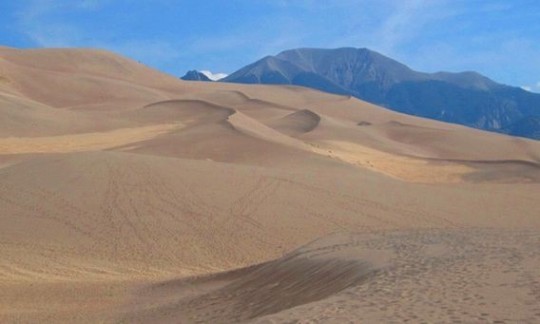


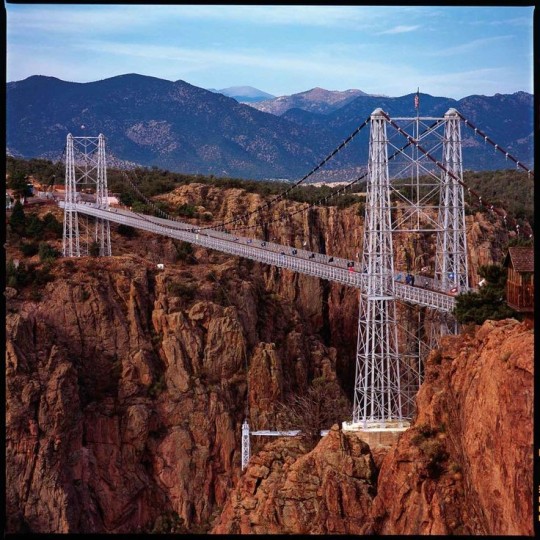

#garden of the gods#Great Sand Dunes National Park and Preserve#telluride#Royal Gorge#pikes peak#stuart gordon#owl creek pass#teocalli mountain#aaron spong#Colorado#Rocky Mountains
0 notes
Text

The significance of this day Day Quiahuitl (Rain, known as Cauac in Maya) is governed by Tonatiuh, the Sun God, as its provider of tonalli (Shadow Soul) life energy. Quiahuitl is a day of relying on the unpredictable fortunes of fate. Tonatiuh - Aztec God of the Sun, Fertility and Sacrifice Talon Abraxas Tonatiuh (pronounced Toh-nah-tee-uh and meaning something like "He who goes forth shining") was the name of the Aztec sun god, and he was the patron of all Aztec warriors, especially of the important jaguar and eagle warrior orders.
In terms of etymology, the name Tonatiuh came from the Aztec verb "tona", which means to shimmer, to shine, or to give off rays. The Aztec word for gold ("cuztic teocuitlatl") means "yellow divine excretions", taken by scholars as a direct reference to excretions of the solar deity. Aspects
The Aztec sun deity had both positive and negative aspects. As a benevolent god, Tonatiuh provided the Aztec people (Mexica) and other living beings with warmth and fertility. In order to do so, however, he needed sacrificial victims.
In some sources, Tonatiuh shared the role as high creator god with Ometeotl; but while Ometeotl represented the benign, fertility-related aspects of the creator, Tonatiuh held the militaristic and sacrificial aspects. He was the patron god of warriors, who fulfilled their duty to the god by capturing prisoners to sacrifice at one of several shrines through their empire. Aztec Creation Myths
Tonatiuh and the sacrifices he demanded were part of the Aztec creation myth. The myth said that after the world had been dark for many years, the sun appeared in heaven for the first time but it refused to move. The dwellers had to sacrifice themselves and supply the sun with their hearts in order to propel the sun on its daily course.
Tonatiuh governed the era under which the Aztecs lived, the era of the Fifth Sun. According to Aztec mythology, the world had passed through four ages, called Suns. The first era, or Sun, was governed by the god Tezcatlipoca, the second one by Quetzalcoatl, the third one by the rain god Tlaloc, and the fourth one by the goddess Chalchiuhtlicue. The current era, or fifth sun, was governed by Tonatiuh. According to the legend, during this age, the world was characterized by maize eaters and no matter what else happened, the world would violently come to an end, through an earthquake. The Flowery War
Heart sacrifice, ritual immolation by excision of the heart or Huey Teocalli in Aztec, was a ritual sacrifice to the heavenly fire, in which hearts were torn out of a war captive's chest. Heart sacrifice also initiated the alternation of night and day and of the rainy and dry seasons, so to keep the world continuing, the Aztecs waged war to capture sacrificial victims, particularly against Tlaxcallan.
The war to gain sacrifices was called "water-burned fields" (atl tlachinolli), the "sacred war" or "flowery war". This conflict involved mock battles between Aztec and Tlaxcallan, in which the combatants were not killed in battle, but rather collected as prisoners destined for blood sacrifice. The warriors were members of the Quauhcalli or "Eagle House" and their patron saint was Tonatiuh; participants in these wars were known as the Tonatiuh Itlatocan or "men of the sun" Tonatiuh’s Image
In the few surviving Aztec books known as codexes, Tonatiuh is illustrated wearing circular dangling earrings, a jewel-tipped nose bar and a blond wig. He wears a yellow headband decorated with jade rings, and he is often associated with an eagle, sometimes depicted in the codexes in conjunction with Tonatiuh in the act of grasping human hearts with its claws. Tonatiuh is frequently illustrated in the company of the solar disk: sometimes his head is set directly in the center of that disk. In the Borgia Codex, Tonatiuh's face is painted in vertical bars in two different shades of red.
One of the most famous images of Tonatiuh is that represented on the face of the stone of Axayacatl, the famous Aztec calendar stone, or more properly Sun Stone. At the center of the stone, the face of Tonatiuh represents the current Aztec world, the Fifth Sun, whereas the surrounding symbols represent the calendric signs of the past four eras. On the stone, Tonatiuh's tongue is a sacrificial flint or obsidian knife protruding outwards.
14 notes
·
View notes
Text

Frederick Catherwood, in Views of ancient monuments in Central America, Chiapas and Yucatan (Frederick Catherwood 1844)
Izamal, at the height of its prosperity, must have been one of the most important of the Indian cities of Yucatan. There is abundant testimony to prove that it was inhabited at the time of the Spanish conquest. There are still remaining several mounds, one of which is the largest in Yucatan, but so dilapitated and disfigured, as to defy accurate measurement: it may be about seven hundred feet long and sixty high. It is said to contain interior chambers and colossal statues; but no entrance at present exists to these subterranean apartments. The great church and convent of the Franciscan monks stands on the upper platform of one of these ancient teocalli, and the open area fronting the church is probably not less than two hundred feet square, surrounded on three sides by an open colonnade, forming a noble promenade, overlooking the modern city of Izamal and the surrounding country to a great distance. On the side of a mound about two hundred feet long, and which formerly had stone and stucco ornaments from one end to the other, is the Colossal Head—perhaps of some deity—represented in the plate: it is seven feet eight inches in height, and seven feet in width. A stone, one foot six inches long, protrudes from the chin, intended perhaps for burning copal on.
48 notes
·
View notes
Text

Storming of the Teocalli by Cortez and His Troops - Emanuel Leutze, 1848
4 notes
·
View notes
Photo

Trono de Moctezuma
El magnífico monumento de piedra conocido como monumento de la guerra sagrada, el Teocalli de la guerra sagrada, la piedra del templo o, simplemente, el trono de Motecuhzoma II (Moctezuma), el rey azteca (tlatoani) que gobernó durante la conquista española, está cubierto de relieves de símbolos, de dioses y del propio Motecuhzoma. El trono, tallado en forma de templo piramidal, conmemora la Ceremonia del Fuego Nuevo de 1507 d.C. y, a través del arte, demuestra el vínculo inseparable entre el fuego y el agua y entre los gobernantes de este mundo y el cosmos eterno. Es una de las obras maestras del arte azteca, y se puede admirar en su hogar permanente en el Museo Nacional de Antropología de la Ciudad de México.
Sigue leyendo...
11 notes
·
View notes
Text
Really appreciating the vibe of Clark Ashton Smith's The Vaults of Yoh-Vombis and The Dweller in the Gulf.
"I have seen the hoary, sky-confronting walls of Macchu Pichu amid the desolate Andes, and the teocallis that are buried in the Mexican jungles. And I have seen the frozen, giant-builded battlements of Uogam on the glacial tundras of the nightward hemisphere of Venus. But these were as things of yesteryear, bearing at least the memory or the intimation of life, compared with the awesome and lethiferous antiquity, the cycle-enduring doom of a petrified sterility, that seemed to invest Yoh-Vombis." - Clark Ashton Smith, The Vaults of Yoh-Vombis.
"More and more, through its uniform breadth, inclination and smoothness, and the demi-arch of cliff above, the shelf impressed the earthmen as being an artificial road. But who could have made and used it? In what forgotten ages and for what enigmatic purpose had it been designed? The imagination of the terrestrials failed before the stupendous gulfs of Martian antiquity that yawned in such tenebrous queries." - Clark Ashton Smith, The Dweller in the Gulf.
Smith's depiction of Mars (and, in a single line, Venus) is rendered hopelessly outdated by modern knowledge, of course, but if you treat it as an alternate history setting, it works pretty well! He did a great job giving the vibe of a dying world with strange and spooky stuff in its out of the way corners and a very long history of civilization (the ruins of Yoh-Vombis are said to be 40,000 years old and there's enough continuity between that time and the modern Martian society that the modern Martians have a historical memory of Yoh-Vombis's builders and its destruction).
Somebody on Sufficient Velocity drew attention to the parallels between The Vaults of Yoh-Vombis and Alien and, yeah, I can see it, enough that it makes me wonder if the former might have been part of the inspiration for the latter. Really appreciating how nasty the parasites in The Vault of Yoh-Vombis are:
They're basically similar in concept to the alien parasites you see in stories like The Puppet Masters, The Hidden, etc., but they've got an extra-nasty touch: after they take control of a host, they eat the top of the host's head, including the brain, and then puppet the mutilated body. If you don't free them from the parasite almost immediately after infection it's impossible to save a person possessed by one; there's no person left to save. It's the ultimate dehumanizing exploitation: the parasite has no use for your personhood, it just wants your body, so it immediately destroys your personhood.
8 notes
·
View notes
Text

Xchicalco ruins, Mexico
Aztec Architecture
Aztecs – also known as Culhua-Mexica, Mexica, Tenochca.
The Aztecs also known as Culhua-Mexica according to britannica.com , originated from nothern Mexico around the 13th century – “just after the fall of the previously dominant Mesoamerican civilisation, the Toltecs.
As said by history.com, some believe that the Aztecs started off as a “northern tribe of hunter-gatherers” who then evolved into the leaders and tribes we know them as today. The Aztecs are best known and remebered for being “the largest of the great Mesoamerican cultures before the Europeans arrived” as described by worldhistory.org. As one of the largest Mesoamerican civilisations they had a lot of power and millions of people/ followers. Aztecs were further renowned for their art and architecture.
The diversity of Aztec architecture is clearly shown through the different styles of the public buildings and regular homes. The two show very different ideas and seperation between public and personal structures. The temples and palaces of the Aztec empire were built with materials such as; basalt, tenzontle, andesite, etc. Whereas some homes were built from stone and others wood and clay. The Aztec period was a class society which meant that the seperation of the poor and rich wasn’t only narrowed down to temples/palaces and then regular homes but a difference within nobles’ homes and the ‘common’ homes too. The wealthier homes were “stone structures which were spacious and well decorated”, as described by aztecsandtenochtitlan.com whereas the common homes were “relatively smaller and simpler”. The difference between dust floors and stone floors is symbolic to how different the nobles and commons lived, the seperation within a society greatly known for its wealth and architectural style.
According to aztecsandtenochtitlan.com “the most important Aztec buildings were their temples and places of worship.” There were many different sized temples (smaller to larger) which defined their importance. The larger of the temples were built on top of the Aztec pyramids (which were copied from previous civilisations and architectural styles with their own Aztec touches). The Aztecs were extremely religious , hence the large temples for worship, so they called their temples “Teocalli” which meant “God houses”.
For some more information have a look at this video:
Aztec architecture introduction - https://youtu.be/RZsljGlDPTY
References:
“Amuzgo | People | Britannica.” Www.britannica.com, www.britannica.com/topic/Amuzgo. Accessed 4 May 2023.
“Aztec Architecture: Introduction.” Www.youtube.com, 2022, www.youtube.com/watch?v=RZsljGlDPTY. Accessed 2 May 2023.
“Aztec Buildings.” Aztecsandtenochtitlan.com, 2019, aztecsandtenochtitlan.com/aztec-architecture/aztec-buildings/.
Cartwright, Mark. “Aztec Civilization.” World History Encyclopedia, 26 Feb. 2014, www.worldhistory.org/Aztec_Civilization/.
History.com Editors. “Aztecs.” History.com, A&E Television Networks, 27 Oct. 2009, www.history.com/topics/ancient-americas/aztecs.
Rogador, Christine. “10 Most Famous Aztec Temples in Mexico - Journey to Mexico.” Journey to Mexico, 7 Dec. 2022, journeytomexico.com/famous-aztec-temples-mexico/.
“Xochicalco Ruins in Mexico.” Www.Pinterest.jp, www.pinterest.jp/pin/376472850100787939/.
8 notes
·
View notes
Text
Over the years, archaeologists have unearthed many offerings at the Templo Mayor, located at the heart of the ancient Aztec, or Mexica, capital of Tenochtitlán and adjacent to contemporary Mexico City’s cathedral. The most recent, the 186th to date, was announced in August: a stone chest filled with objects from the sea and 15 anthropomorphic sculptures in green stone, dating from the reign of Moctezuma Ilhuicamina (1440–69).
The discovery was made by archaeologists Alejandra Aguirre Molina and Antonio Marín Calvo, working under the direction of Juan Ruiz Hernández of the Proyecto Templo Mayor—an ongoing restoration effort focused on one of the great archaeological landmarks of ancient Mexico. It was founded by Eduardo Matos Moctezuma in 1978 not long after utility workers discovered a statue of the Aztec goddess of the moon, Coyolxauhqui, at the Templo Mayor site. The initiative is currently directed by archaeologist Leonardo López Luján.
The offering was left on a platform on the rear facade of the Huei Teocalli, to use the Nahuatl name for the Templo Mayor, a few centimeters away from an area impacted 123 years ago by the placement of a sewage pipe. The offering box includes 14 anthropomorphic male sculptures and one female figurine. This artifact dates from the time of the first Moctezuma to rule Tenochtitlán, in the middle of the 15th century.
According to the researchers, the sculptures carved from green stone exhibit characteristics of the Mezcala style from the northern highlands of the Mexican state of Guerrero, about 200 miles south of Mexico City. Among these sculptures, one that is 30 centimeters high stands out in contrast to the other figurines that are as small as 3 centimeters tall. All have some unique features, and the style of the figures and their origin in the state of Guerrero has led the archaeologists to speculate that they arrived at the Templo Mayor following the Aztec conquest of the region. Like all Aztec rulers, Moctezuma I Ilhuicamina, whose full name in Nahuatl is Motēuczōmah īlhuihcamīna, was a powerful leader of the civilization which had its capital at Tenochtitlán. He ruled between 1440 and 1469 and was the fifth tlatoani, or ruler of Tenochtitlán. Moctezuma I expanded the territory of his empire through a series of military campaigns and conquests. During his reign, the Triple Alliance (which consisted of Tenochtitlán and the nearby cities of Texcoco and Tlacopan) succeeded in conquering several neighboring peoples and expanding its influence in the Mesoamerican region.
In addition to his military achievements, Moctezuma I is remembered for his focus on the cultural and religious development of Tenochtitlán. He promoted the construction and decoration of many temples and monuments, including the Templo Mayor, the most important ceremonial center of the Mexica civilization. “When the Mexica subdued these peoples, the figurines were already relics, some of them are more than 1,000 years old, and presumably served as cult effigies, which the Mexica appropriated as spoils of war,” explains Luján.
Aguirre and Marín, who also worked with Sofía Benítez Villalobos, a specialist in restoring artifacts, have concluded that, after they were brought to Tenochtitlán, the sculptures underwent a ritual that transformed them and incorporated them into the religious life of Tenochtitlán. They point to traces of facial painting that the Mexica added to the figurines, associated with the god of rain, Tlaloc. In addition to the sculptures, offering 186 included two earrings in the shape of rattlesnakes and a total of 137 beads made of various green stones, accompanied by sand and 1,942 different elements from the ocean including shells, snails, and corals.
Originally from the coasts of the Atlantic Ocean, a region subdued by the Triple Alliance in the time of the first Moctezuma, the seashells have been restored, and the responsibility for their biological identification lies with Belem Zúñiga Arellano, a member of the Proyecto Templo Mayor team.
The discovery of this offering builds on archaeologists’ interest in verifying a pattern observed in earlier offerings, specifically 18, 19, and 97. These consisted of stone chests that were buried as part of dedication offerings under monumental serpent heads located on the platform of the Templo Mayor. All these offerings may provide a better understanding of how the Aztecs viewed the Templo Mayor.
“In the classic Nahuatl language, these chests were known as tepetlacalli, from tetl, or stone, and petlacalli, a box made of mats. In their homes, the Mexica would store their most precious belongings—fine feathers, jewelry, and cotton garments—in chests made from petate (a type of palm). If we look at the Templo Mayor, which represents a sacred mountain full of provisions, we can imagine the priests storing in these ‘stone chests’ the quintessential symbols of water and fertility: sculptures of the rain gods, green stone beads, shells, and snails,” López Luján explains.
By 2024, the Proyecto Templo Mayor plans to ask the Archaeology Council of Mexico’s Instituto Nacional de Antropología e Historia, the government body that administers all of the country’s archaeological sites, for permission to temporarily remove a serpent's head located on the northern side of the Templo Mayor. It is likely that even more treasures will soon see the light of day again.
5 notes
·
View notes
Photo
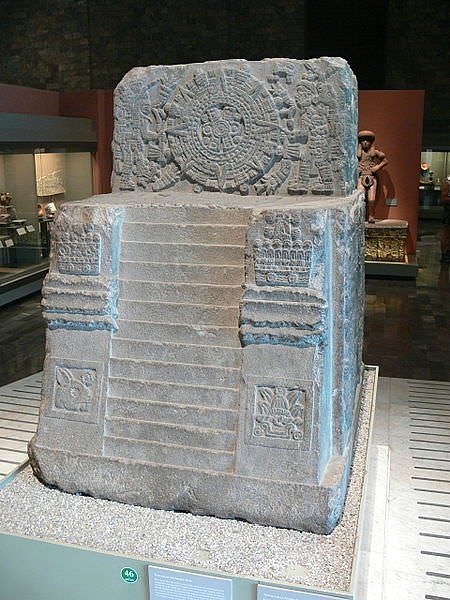
Trône de Montezuma
Le magnifique monument de pierre, appelé tour à tour Monument de la guerre sacrée, Teocalli de la guerre sacrée, Pierre du temple ou, plus simplement, trône de Montezuma II (Moctezuma), le roi aztèque (tlatoani) qui régnait à l'époque de la conquête espagnole, est recouvert de sculptures en relief représentant des symboles, des dieux et Montezuma lui-même. Le trône, sculpté en forme de temple pyramidal, commémore la cérémonie du nouveau feu de 1507 et démontre par l'art le lien indissociable entre le feu et l'eau et entre les dirigeants de ce monde et le cosmos éternel. Il s'agit de l'un des chefs-d'œuvre de l'art aztèque, que l'on peut admirer dans sa résidence permanente au Musée national d'anthropologie de Mexico.
Lire la suite...
2 notes
·
View notes
Text
[Photo ID: I'm not sure where the first image is from because reverse image search isn't helping but it's one of the indigenous people of Mactan (one of the islands of the Philippines), possibly Lapulapu, Datu of Mactan, mostly naked staring down Ferdinand Magellan (in armour cowering in the water) with a giant sword about to kill him during the Battle of Mactan. In the background are more Spanish soldiers getting off a boat with guns ready to fight. In addition behind Lapulapu are more Macatans one of whom has another Spaniard soldier tied up and they are in front of a burning building. The image has "Fuck Magellan" in all caps over it.
The second photo is "The Death of Captain James Cook, 14 February 1779" by Johan Zoffany. Cook had attempted to kidnap the Hawaiian chief (aliʻi nui) Kalaniʻōpuʻu, "they were confronted by a crowd of Hawaiians at Kealakekua Bay seeking to rescue their hostage. The ensuing battle killed Cook and several Royal Marines, as well as several Hawaiians. Kalaniʻōpuʻu survived the exchange." The painting shows a very chaotic battle between the native Hawaiians and the British Royal Navy. "Fuck James Cook" is written in all caps over this painting.
The third image is Spaniards Enslaving the Indians, a book Illustration from Indian Horrors or Massacres of the Red Men, by Henry Davenport Northrop, 1891. This image shows Spanish conquistadors shackling and enslaving Native Americans. "Fuck Christopher Columbus" is written in all caps over the image.
The last image is The Storming of the Teocalli by Cortez and His Troops, an oil-on-canvas painting by Emanuel Leutze. This painting shows Cortez and his men attacking the Aztecs on the Huey Teocalli (Great Temple)/Templo Major (Main Temple) that was destroyed by the Spanish in 1521 and was replaced by the Mexico City Metropolitan Cathedral. A teocalli is a pyramid surrounded by a temple. The painting has "Fuck Hernan Cortez" in all caps on it.
End ID]
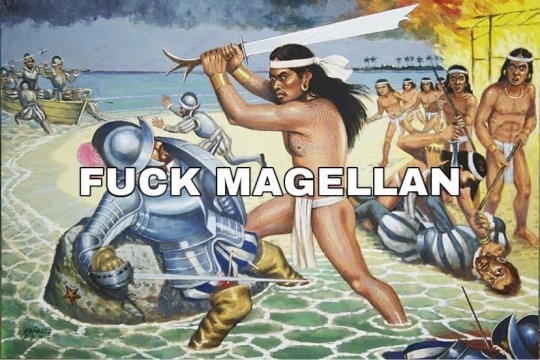

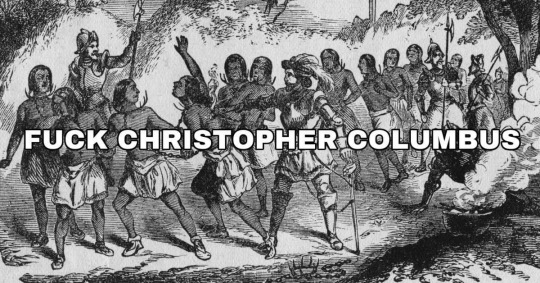
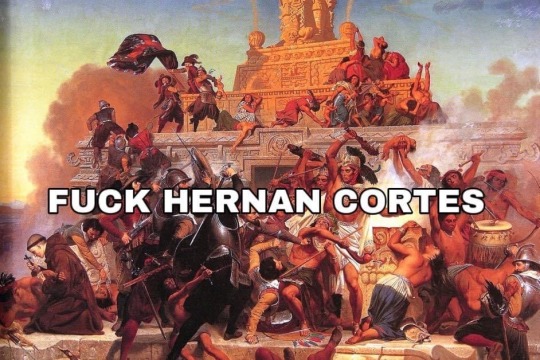
69K notes
·
View notes
Text

gateway of the great teocallis, uxmal, frederick catherwood
0 notes
